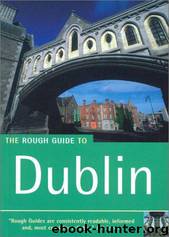The Rough Guide to Dublin by Mark Connolly

Author:Mark Connolly [Connolly, Mark]
Language: eng
Format: epub
Tags: General, Travel, Europe, History, Ireland, Dublin (Ireland)
ISBN: 9781858289137
Publisher: Rough Guides
Published: 2003-01-01T00:00:00+00:00
Rathfarnham Castle
May–Oct daily 9.30am–5.30pm, last admission one hour before closing; guided tour €1.90. www.heritageireland.ie. Bus #16 or #16A from O’Connell St or Dame St.
Rathfarnham Castle has been undergoing restoration since 1987, and work is still far from finished, but if you’re interested in historic monuments and their conservation, the guided tour is worthwhile. Built around 1583 by Adam Loftus, Rathfarnham appears today as an impressive semi-fortified mansion. Loftus was a Yorkshireman who came to Ireland as the Lord Deputy’s chaplain and went on to become both Archbishop of Dublin, the first Provost of Trinity College and Lord Chancellor of Ireland – clearly a man of considerable wealth. The Dublin Hearth Money Roll of 1664 found only twenty establishments in the county with over eight hearths, and with eighteen, Rathfarnham was the largest of these. In the 1720s the battlements were removed and, while the overall exterior retains its sixteenth-century appearance, the interior is that of a stately Georgian residence.
The castle passed through a number of hands in the seventeenth and eighteenth centuries, but in 1767 it was bought by Nicholas Loftus, second earl of Ely, a descendant of the archbishop and something of an eccentric, who erected a triumphal arch at the north entrance to the grounds. At one point he was nearly judged insane, but escaped committal thanks to his uncle, Henry Loftus, who defended him in court and inherited Rathfarnham after his death. It was Henry who made Rathfarnham a byword for luxury and refinement, hiring Sir William Chambers and James “Athenian” Stewart to remodel the rooms, and installing aviaries and menageries in the grounds. In subsequent years the castle fell into decline, and in 1913 part of the land was sold off for a golf course – the castle itself was bought by the Jesuits.
Today the kitchen wing has been fully restored and although conservation work is still ongoing in the eighteenth-century apartments, they do give you some sense of the scale of Rathfarnham’s former grandeur.
Download
This site does not store any files on its server. We only index and link to content provided by other sites. Please contact the content providers to delete copyright contents if any and email us, we'll remove relevant links or contents immediately.
Crystal Cove by Lisa Kleypas(37398)
Spell It Out by David Crystal(35347)
Underground: A Human History of the Worlds Beneath Our Feet by Will Hunt(11256)
Tools of Titans by Timothy Ferriss(6945)
Giovanni's Room by James Baldwin(5877)
The Rosie Project by Graeme Simsion(5189)
A Year in the Merde by Stephen Clarke(4652)
Perfect Rhythm by Jae(4621)
Spare by Prince Harry The Duke of Sussex(4195)
China Rich Girlfriend by Kwan Kevin(3892)
Endurance: Shackleton's Incredible Voyage by Alfred Lansing(3840)
The Body: A Guide for Occupants by Bill Bryson(3799)
Beach Read by Emily Henry(3798)
The Silk Roads by Peter Frankopan(3759)
A Game of Thrones 1 by George R R Martin(3655)
Tokyo Vice: An American Reporter on the Police Beat in Japan by Jake Adelstein(3439)
The Motorcycle Diaries by Ernesto Che Guevara(3332)
Alive: The Story of the Andes Survivors by Piers Paul Read(3310)
For the Love of Europe by Rick Steves(3196)
